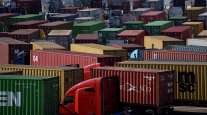Staff Reporter
Indicators Show Slowdown in Growth, but Recession Isn’t Likely

[Stay on top of transportation news: Get TTNews in your inbox.]
Jitters and trade wars are roiling the markets and troubling freight companies, but the big question is if the U.S. economic expansion may be coming to a close soon.
That debate is going on in the market in real time, with indicators flashing but not staying lit, said some experts.
“All I am seeing is fear,” said Rajeev Dhawan, director of the Economic Forecasting Center at Georgia State University. “I’ve not seen the second step, which is when the credit market is gummed up.”

Dhawan
Yet trade and recession fears finally boiled over Aug. 14. The Dow Jones industrial average shed 800.49 points, or 3.05% of value, to 25,479.42. Another bad sign that day was when government bonds showed an inverted yield curve, something that usually precedes a recession by months. An inverted yield curve happens when the benchmark 10-year Treasury note falls below the two-year rate, a sign investors have little faith in the long term.
The inverted yield curve soon corrected itself, and the Dow had regained 483 points by the close of business Aug. 20. In morning trading Aug. 21, it had added 265 points.
In the freight industry, few would say things are as strong as they were in the peak months of 2018. The data bear this out, as one longtime researcher noted that the sector has been on the downswing this year.

Vieth
“The vast majority of truck-related data since late in the fourth quarter of 2018 have been negative,” said Kenny Vieth, president and senior analyst at ACT Research in Columbus, Ind., results he said indicate that the freight sector could be in its own recession. “If you use two quarters of negative results, it’s a good rule of thumb for a recession,” he told Transport Topics, adding that several freight-related indicators — along with data for other industries — have been negative in that six-month time frame. Specifically, Vieth noted that U.S. manufacturing shrunk by 1.1% in six months from its December peak.
However, some experts don’t like the word “recession” for the freight subeconomy — or any other particular industry.
“Recession is a very strong term,” Dhawan said. He pointed to the slowdowns in 2016, which some also called a “freight recession.” Dhawan instead calls them a stall or a swoon during an overall U.S. growth period.
Dhawan said a major cause of recession is the freezing of credit or liquidity when banks loan to each other, and he is not seeing that indicator. Inverted yield bonds and gummed-up credit have to last for a period of time before recession is triggered, he said.
The U.S. economy last entered a recession at the end of 2007, and it lasted until July 2009. The nation is now in a long period of expansion. In the second quarter of this year, GDP expanded at a 2.1% annualized rate, according to Commerce Department data July 26.
On Aug. 20, a key metric was released by American Trucking Associations that indicated the economy seems far from recessed. Truck tonnage surged 7.3% compared with July 2018, the largest year-over-year gain since April, according to ATA.
“It’s important to note that May and June were soft, so some catch-up here,” ATA Chief Economist Bob Costello said in a tweet. “Still, this is a good sign that economy isn’t dead yet!”
Just released from @TRUCKINGdotORG: July seasonally adjusted for-hire truck tonnage (TL<L) jumped 6.6% from June and 7.3% from July 2018. Its important to note that May & June were soft, so some catch up here. Still, this is a good sign that economy isn't dead yet! — Bob Costello (@ATAEconBob) August 20, 2019
Morgan Brennan, CNBC’s co-anchor of Squawk Alley, tweeted, “Reminder: truck tonnage has historically been a solid early indicator of US economic growth.”
Reminder: truck tonnage has historically been a solid early indicator of US economic growth https://t.co/1Fv3N3z3dc — Morgan Brennan (@MorganLBrennan) August 20, 2019
More broadly, economists told TT that White House trade policy is applying headwinds to what otherwise remains an ongoing economic expansion. In particular, they point to the U.S.-China standoff, with the two giants slapping tariffs on each other’s steel, soybeans and more.
“There are two things we are worried about,” said Robert Dieli, the in-house economist for Illinois research firm MacKay & Co. “The trade war — the longer it lasts, the more it affects the supply chain.”
The second point of concern, Dieli told TT, are the bigger effects it could have further down the economic line. For example, if trucks begin transporting less Chinese steel because of U.S. tariffs, they may be off the road more often. That means fewer truck stops for fuel, and ultimately less wear and tear. That means less demand for brake pads. Then the economy takes a secondary hit, Dieli said.
“If it turns out to be a permanent change, it will have reverberations beyond Chinese steel,” Dieli said.
In his study of the freight industry, Dieli said he believes much freight was moved to and from the United States in 2017 and 2018 to avoid possible tariffs in 2019. U.S. businesses pulled a lot of 2019 demand and planning into 2018, thus leaving 2019 with less activity, Dieli said.
“Those effects were not trivial,” he said.
The ongoing trade war with China is further shrinking the 2019 pie, said Vieth.
“You inject uncertainty into the business planning process,” Vieth said of Trump’s tariffs. “It’s hard to plan when the rules keep getting changed.”



